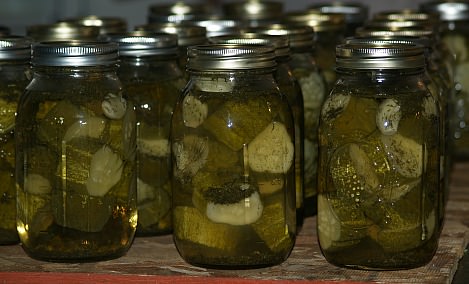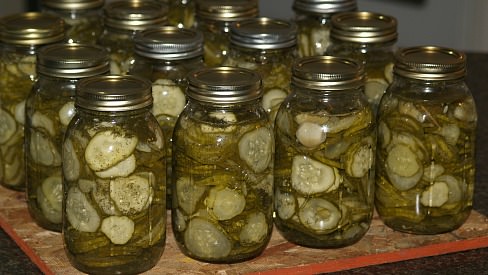- Painless Cooking
- Canning Techniques and Recipes
- Dill Pickles
How to Make Dill Pickles
As a child, I always wanted to learn how to make dill pickles. This was way before I ever thought I could make them. My sister, Ardice usually kept a small jar of dills in her refrigerator. This was one of the reasons that I loved going to her house. Back then I thought these delicious slices in that small jar were miraculously made by someone far larger than me. I never dreamed that I would ever learn how to make them.
Mom and Dad canned many pickles but nothing that tasted like my sister’s. They mostly canned German sour pickles which did not have dill in them. Also, remember back then we did not have all these “hamburger joints” like we do today where dill pickles are common place. When I got a little older, I remember Dad stopping at White Castle when we made trips to Cincinnati to see Sister Lillian. I think the one reason I loved those White Castle Burgers is because of all the dill pickles I got on my little burger.
Until I learned how to make dill pickles I could never have realized how easy they are to make. Some can be as easy as pouring brine over cucumbers or other vegetables and storing them in the refrigerator. Of course, how many we make must be limited depending on the space in our refrigerator. Even the other recipes are quite simple because they all contain vinegar. The vinegar is very acidic so the pickles require no pressure canning. The pressure canning takes more time and effort. Normally the canning of vegetables requires pressure canning for safety.
NOTE: Most recipes do not specify the type of vinegar. I use white “distilled” or apple cider vinegar interchangeably. The main thing to check is the acidity percentage. It should always be around 5% to process correctly.
Some recipes will instruct you to fill the jars and simply seal with lids. I almost always choose to process the jars in a boiling water bath. I do this for at least 10 minutes to make sure they seal. The reason people do not like to use the boiling water bath is that the heat will soften the pickles. The longer you process with heat, the softer the pickles.
When learning how to make dill pickles you will find various tips on preventing too much softening. A common ingredient in most pickle recipes is salt. Most recipes will specify kosher, canning or natural salt. Dill pickles need to go through a curing process. Salt, sugar, spices or combinations creates acid which helps this fermentation along. Salt also helps to make finished pickles crunchy. If a recipe does not specify a certain type of salt, use canning or a natural one like sea salt.
Another ingredient found in many pickle recipes is “alum”. Alum (Also known as potash alum and potassium sulfate.) is the type you find in the spices at the grocery store. It is used for all kinds of pickling and is also found in baking powder. Alum is used to make pickles crisper. Alum does contain aluminum which is why many people hesitate or refuse to use it.
Another tip I found for helping the crispness when I learned how to make dill pickles is adding a grape leaf. Add a fresh grape leaf (or piece of large one) at the top of each jar before filling. This was the first year that I had access to fresh grape leaves to use in my pickles. I washed the leaves and dried them first. I tucked the smaller whole leaves in the top of each jar. The leaves which were extremely large, I cut in half before using. After about six months, I will do a crispness check (That is if any are left then.)
When learning how to make dill pickles many seem to have problems with too soft or salty pickles. Many recipes instruct a “salt soaking” before the canning. This salt must be thoroughly washed from the pickles. Do this by rinsing several times with fresh cold water and draining thoroughly each time. I have also had a few recipes which I simply cut the salt a little.
As I mentioned above, soft pickles often come from processing in heat too much. Have the processing water boiling when putting in the jars and start timing at that minute. If your jars are cool, you can set them in the sink in warm water first to prevent the jars from breaking. As soon as the processing time is up, remove the jars to a towel covered counter to cool. Place the jars far apart so air can flow through allowing them to cool quicker. You can also try the alum or grape leaves which I mentioned above to make crisper pickles.
NOTE: TO WASH MY CUCUMBERS I add a little bleach to fresh cold water. After rinsing thoroughly with fresh cold water, I drain them and dry.
EASY DILL PICKLE RECIPE
Learn how to make dill pickles with this easy recipe. Cucumbers can be whole, speared, sliced or cut into chunks.
- ¾ Cup canning salt
- 12 Cups water
- 7 Cups vinegar (5%)
- 1 Teaspoon dried dill weed (For each quart jar)
- 2 Cloves garlic (For each quart jar)
- 90-100 Pickling cucumbers (About 4 inches long)
Wash cucumbers and dry; trim ends off; leave whole, slice, strip or cut in chunks.
Place cucumbers in a large container (I prefer one with a flat bottom.)
Layer cucumbers with ice and cover top with ice; cover with a large clean towel and let stand 3 hours.
Drain cucumbers well.
Combine salt, water and vinegar; heat to boiling.
Pack cucumber into jars leaving 1 inch headspace; add dill and garlic to each jar.
Pour boiling vinegar mixture over pickles in each jar leaving ½ inch headspace.
Adjust lids; process in boiling water bath for 15 minutes.
KOSHER DILL PICKLES RECIPE
- Pickling cucumbers
- 1 Clove garlic (For each jar)
- Fresh dill heads (1 for each jar)
- 1/8 Teaspoon alum (For each jar)
- Red pepper flakes (To taste in each jar)
- 1 Cup pickling salt
- 3 Quarts water
- 1 Quart vinegar
Wash cucumbers; pack in sterilized jars.
To each jar add a little red pepper if desired, alum, garlic and head of dill.
Combine vinegar, water and salt; bring to a boil and boil for 10 minutes.
NOTE: Brine is enough for 7 quarts. You may want to multiply the recipe.
Pour mixture over all leaving ½ inch headspace; adjust lids.
Process in boiling bath for 10 minutes.
SWEET AND SOUR DILL CHUNKS RECIPE
Learn how to make dill pickles that are sweet and sour. These make are a great ingredient to add into many salads.
- Cucumbers (To fill 4 quart jars)
- 12 Onion slices
- 2 Stalks celery (Cut in quarters)
- 8 Dill heads
- 4 Cups sugar
- ½ Cup salt
- 4 Cups vinegar
- 2 Cups water
Wash cucumbers; trim off ends and cut into 1 inch chunks.
Place cucumbers in quart jars; add to each jar 3 onion slices, 2 pieces of celery and 2 dill heads.
Dissolve sugar and salt in the vinegar and water; bring to a boil.
Pour boiling mixture over the pickles in the jars leaving ½ inch headspace.
Adjust lids; process in boiling water bath for 15 minutes.
HOW TO MAKE DILL PICKLE SPEARS RECIPE
- 1 Quart vinegar
- 1 Quart water
- ¾ Cup sugar
- ¾ Cup canning salt
- 3 Tablespoons pickling spices
- 25 to 30 pickling cucumbers (Cut into quarters lengthwise)
- 8 Fresh dill heads
- 8 Cloves garlic
Combine in a saucepan the vinegar, water, sugar and salt; bring to a boil.
Tie pickling spices in a cheesecloth or spice bag; place in hot liquid.
Bring liquid to a boil boiling for 10 minutes; remove spice bag and discard.
Pack cucumbers in jars leaving ½ inch headspace; place 1 clove of garlic in each jar.
Pour boiling liquid over the cucumbers in jars leaving ¼ inch headspace.
Adjust lids; process in boiling water bath for 10 minutes.
GARDEN REFRIGERATOR DILL PICKLES
Learn how to make dill pickles with other vegetables beside cucumbers. This one is made with yellow squash and zucchini squash with green bell peppers, red bell peppers and onions.
- 2 Cups sugar
- 1 Cup apple cider vinegar
- 3 ½ Cups yellow summer squash (Thinly sliced)
- 3 ½ Cups zucchini squash (Thinly sliced)
- 1 Cup onions (Thinly sliced)
- 1 Cup green bell pepper (Thinly sliced)
- 1 Cup red bell pepper (Thinly sliced)
- 1 Tablespoon salt
- 1 Tablespoon dill seeds
Combine sugar and vinegar in a nonreactive saucepan until sugar dissolves.
Add remaining ingredients; chill overnight.
Transfer pickles to sterilized quart canning jars; cover with vinegar mixture.
Adjust lids and seal jars.
These will keep in the refrigerator for up to 2 months.
NO SALT DILL PICKLES RECIPE
- 1 Teaspoon dill seed (For each jar)
- 1 Teaspoon pickle spice (For each jar)
- 1 Cup white vinegar (5 % acidity) (For each jar)
- Sliced cucumbers
- Quart jars
Wash cucumbers and slice; pack in sterilized quart jars.
Add dill, spice mix and white vinegar; fill jars with fresh water.
Adjust lids on jars; process in boiling water bath for 10 minutes.






